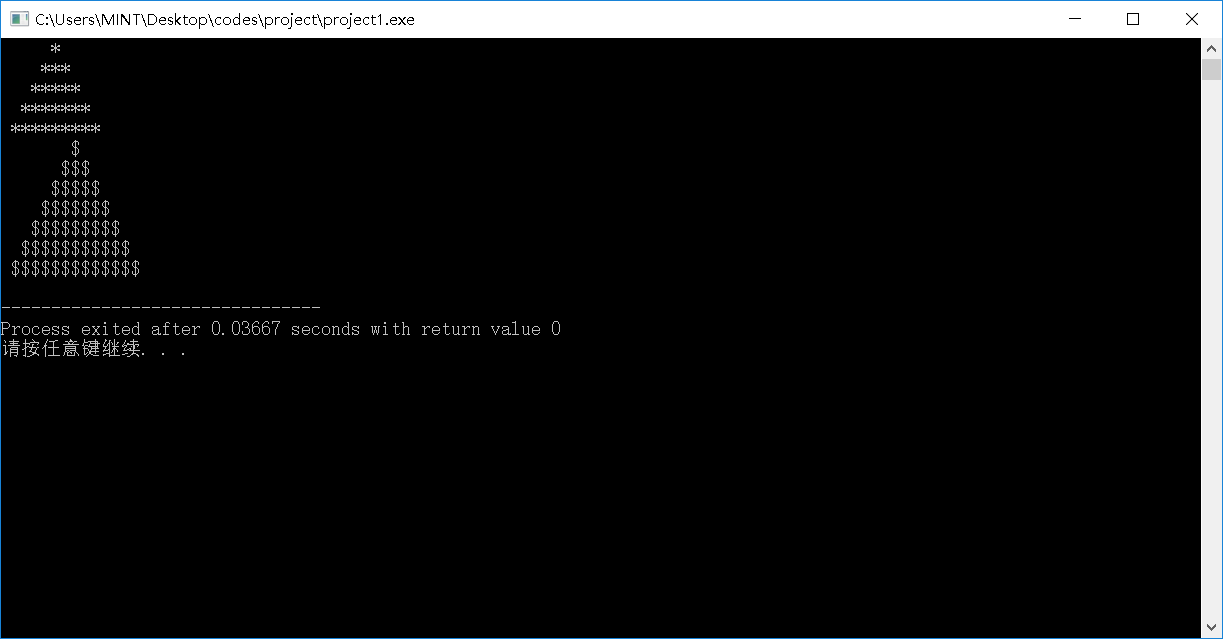四、实验结论
1. 实验内容 2
类的定义
//graph.h
#ifndef GRAPH_H #define GRAPH_H // 类Graph的声明 class Graph { public: Graph(char ch, int n); // 带有参数的构造函数 void draw(); // 绘制图形 private: char symbol; int size; }; #endif
类的实现
//graph.cpp
include "graph.h"
#include <iostream>
using namespace std;
// 带参数的构造函数的实现
Graph::Graph(char ch, int n): symbol(ch), size(n) {
}
// 成员函数draw()的实现
// 功能:绘制size行,显示字符为symbol的指定图形样式
// size和symbol是类Graph的私有成员数据
void Graph::draw() {
int i;
for(i=0;i<size;i++)
{
for(int j=size-i-1;j>=0;j--)
cout<<" ";
for(int j=0;j<=2*i;j++)
cout<<symbol;
cout<<endl;
}
}
main函数
//main.cpp
#include <iostream> #include "graph.h" using namespace std; int main() { Graph graph1('*',5), graph2('$',7) ; // 定义Graph类对象graph1, graph2 graph1.draw(); // 通过对象graph1调用公共接口draw()在屏幕上绘制图形 graph2.draw(); // 通过对象graph2调用公共接口draw()在屏幕上绘制图形 return 0; }
运行结果截图

运行环境为devc++
2.实验内容3
类的定义
//fraction.h class fraction { public: fraction(); fraction(int x,int y); fraction(int x); void show(); void add(fraction &b);//加 void min(fraction &b);//减 void mul(fraction &b);//乘 void div(fraction &b);//除 void cmp(fraction &b,fraction &c);//比较 private: int top; int bottom; };
类的实现
//fraction.cpp
#include<iostream>
#include"fraction.h"
using namespace std;
fraction::fraction()
{
top=0;
bottom=1;
}
fraction::fraction(int x,int y)
{
top=x;
bottom=y;
}
fraction::fraction(int x)
{
top=x;
bottom=1;
}
void fraction::show()
{
cout<<top<<'/'<<bottom<<endl;
}
void fraction::add(fraction &b)
{
fraction a;
a.top=top*b.bottom+b.top*bottom;
a.bottom=bottom*b.bottom;
a.show();
}
void fraction::min(fraction &b)
{
fraction a;
a.top=top*b.bottom-b.top*bottom;
a.bottom=bottom*b.bottom;
a.show();
}
void fraction::mul(fraction &b)
{
fraction a;
a.top=top*b.top;
a.bottom=bottom*b.bottom;
a.show();
}
void fraction::div(fraction &b)
{
fraction a;
a.top=top*b.bottom;
a.bottom=bottom*b.top;
a.show();
}
void fraction::cmp(fraction &b,fraction &c)
{
double m,n;
m=b.top/b.bottom;
n=c.top/c.bottom;
if(m<n)
{
cout <<b.top<<'/'<<b.bottom<<'<';c.show();cout<<endl;
}
else if(m==n)
{
cout <<b.top<<'/'<<b.bottom<<'=';c.show();cout<<endl;
}
else
{
cout <<b.top<<'/'<<b.bottom<<'>';c.show();cout<<endl;
}
}
main函数
//main.cpp
#include <iostream>
#include "fraction.h"
using namespace std;
int main()
{
fraction a;
fraction b(3,4);
fraction c(5);
a.show();
b.show();
c.show();
c.add(b);
c.min(b);
c.mul(b);
c.div(b);
b.cmp(b,c);
return 0;
}
运行结果截图

运行环境为devc++
五、实验总结与体会
把一个完整的关于类和对象的程序拆成几个部分做成项目,“类的实现”那个单元需要包含#include<iostream>这个头文件,以及“类的实现”和“main函数”的单元中都需要在头文件中包含进“类的定义"的那个单元。
除此以外,和上次的作业相比没有特别新的知识点。